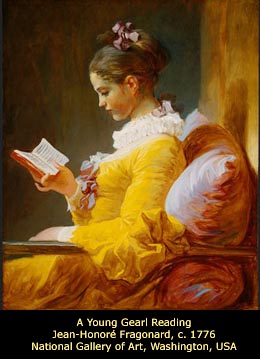A Young Girl Reading
Jean-Honoré Fragonard, 1776
Rococo
National Gallery of Art, Washington, USA
French painter Jean-Honore Fragonard (1732 - 1806) as a young teenager apprenticed
to Jean-Baptiste-Siméon Chardin for six months.
Then he worked short time in François Boucher's studio and became his most brilliant pupil.
Next three years he spent in Carle van Loo atelier. From 1756 to 1761 he was studying at
the Académie de France in Rome but he opted out of an official career of history painting.
Preferring to make lighthearted, erotic pictures for his private clients and patrons,
he exhibited at the Salon only twice.
His cheerful canvases reinvigorated the Rococo style. He painted mythological scenes, elegant
genre scenes, gallantry, landscapes, and portraits.
"A Young Girl Reading" painted in 1776 is considered to be one of the
most charming and appealing works of Fragonard. It represents a young girl whose identity
is unknown. Resting on fluffy pillows, she is holding a book completely absorbed in her reading or being lost in the world of her private
thoughts.
The soft warm tones, vivid light, delicate coloring, witty characterization,
irresistible verve and joyfulness of the picture represent Fragonard's brilliant style, often called
"Frago" style. Inspired by Dutch masters Fragonard lovely depicts surface
texture and the material of which each object is made.
The girl's lemon-yellow dress and fluffy light-brown cushion highlighted in
light purple are painted with quick and fluid strokes. Her fingers painted with
quick light touch of the brush seem to tap out a rhythm that runs through the whole
painting. To achieve more expressive outcome Fragonard used the wooden tip of a brush
to scratch her wheel-shaped stiff white collar almost into the surface of the paint.
This "swordplay of the brush" technique of painting
not always joined the common approval.
Fragonard's masterpieces were marked by his careful study of the Dutch
17th-century masters as Rubens, whose influence is visible in most of his masterpieces.
Rubenesque enamel-like surface of the painting, the blended brushstrokes which he used to
convey the details so precisely unavoidably can be seen only in Dutch artists.
